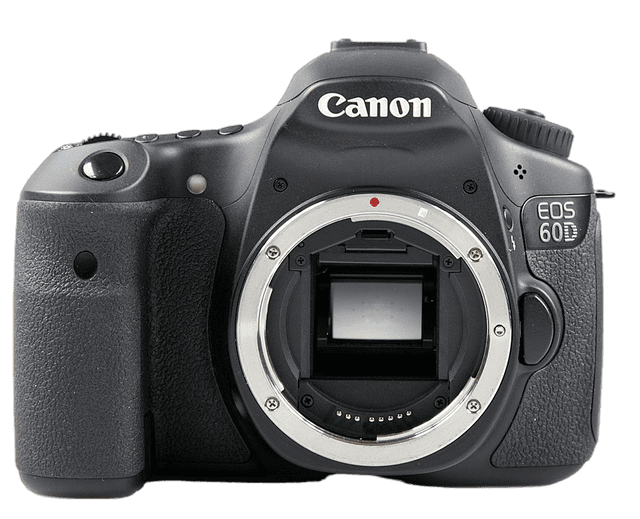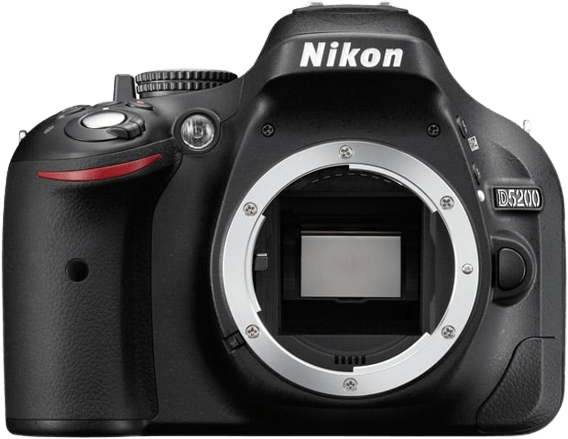Canon EOS 60D vs Nikon D5200 Comparison
Canon EOS 60D

Nikon D5200

The Nikon D5200 triumphs over the Canon EOS 60D with a score of 56/100, a 9-point lead over the 60D’s 47/100. Both cameras are DSLRs released in the early 2010s, with the 60D in 2010 and the D5200 in 2012. They share similarities in specifications, such as camera type and size; the 60D measures 145 x 106 x 79mm, while the D5200 is slightly smaller at 129 x 98 x 78mm.
The D5200 outperforms the 60D with its lower launch price of $897 compared to the 60D’s $1,199. Additionally, the D5200 is lighter, weighing 555g versus the 60D’s 755g. However, the 60D has its merits, boasting a more robust build and larger size, which may appeal to some users. Ultimately, the Nikon D5200’s affordability and lighter weight make it the superior choice, but the Canon EOS 60D remains a solid option for those who prefer a slightly larger and sturdier camera.
Canon EOS 60D vs Nikon D5200 Overview and Optics
The Nikon D5200 outperforms the Canon EOS 60D in optics with a score of 65/100 compared to the Canon’s 43/100. Both cameras share common specifications such as a CMOS sensor, APS-C sensor size, and a lack of image stabilization. However, the Nikon D5200 excels in certain aspects, making it the winner in this comparison.
The Nikon D5200 has a higher megapixel count at 24.1, compared to the Canon EOS 60D’s 18 megapixels. This enables the Nikon to capture more detail in images. Additionally, the Nikon D5200 has a superior DXOMARK sensor score of 84, compared to the Canon’s score of 66. The higher score indicates that the Nikon’s sensor performs better in terms of color depth, dynamic range, and low-light performance.
Although the Nikon D5200 has a slightly slower shooting speed at 5 frames per second compared to the Canon EOS 60D’s 5.3 frames per second, this difference is negligible and unlikely to impact the overall performance of the camera. Both cameras use different processors, with the Nikon utilizing the Expeed 3 and the Canon using the Digic 4. The Expeed 3 processor contributes to the Nikon’s better image quality and sensor performance.
The Canon EOS 60D’s advantages are limited to its slightly faster shooting speed and its Canon EF-S lens mount, which might be preferable for those who already own Canon lenses. However, the Nikon D5200’s Nikon F DX lens mount provides a wide range of compatible lenses as well.
Taking all factors into consideration, the Nikon D5200 is the superior choice when it comes to optics, with its higher megapixel count and better sensor performance. The Canon EOS 60D’s advantages do not outweigh the overall better performance of the Nikon D5200 in this comparison.
Canon EOS 60D vs Nikon D5200 Video Performance
The Nikon D5200 outperforms the Canon EOS 60D in video capabilities with a significant 27-point difference in their scores, 70/100 and 43/100 respectively. Both cameras share Full HD video resolution and max video dimensions of 1920 x 1080, but the D5200 excels in other key aspects.
The winning camera, the Nikon D5200, has a max video frame rate of 60fps, which is double the 30fps offered by the Canon 60D. This higher frame rate allows for smoother and more detailed video capture, especially in fast-moving scenes. Additionally, the D5200 has built-in time-lapse functionality, a feature that the 60D lacks. Time-lapse videos can create stunning visual effects and showcase the passage of time in a unique way, making this a valuable asset for the D5200.
Despite its lower score, the Canon 60D still has some advantages over the Nikon D5200. However, these advantages are not related to video capabilities. The comparison focuses on video performance, and in this aspect, the Nikon D5200 is the clear winner.
The Nikon D5200’s superior video frame rate and built-in time-lapse functionality make it a better choice for those prioritizing video capabilities. While the Canon 60D shares some common specifications, it falls short in key areas, resulting in a lower overall video score. As a result, the Nikon D5200 emerges as the preferred option for video enthusiasts.
Canon EOS 60D vs Nikon D5200 Features and Benefits
The Canon EOS 60D outperforms the Nikon D5200 with a feature score of 57/100, a clear 27-point lead over the Nikon’s 41/100. Both cameras have a 3-inch screen, no touchscreen, a flip screen, and no GPS, WIFI, or Bluetooth capabilities.
The Canon EOS 60D surpasses the Nikon D5200 with its screen resolution of 1,040,000 dots, providing a sharper and clearer display. This advantage allows users to review their photos and videos with greater accuracy and detail. The higher feature score of the Canon EOS 60D also indicates that it offers more versatile options and capabilities, enhancing the overall user experience.
On the other hand, the Nikon D5200 does not surpass the Canon EOS 60D in any specific features, as both cameras share the same specifications in several aspects. However, its lower feature score might appeal to those seeking a more budget-friendly option or a simpler camera for casual photography.
Taking these factors into account, the Canon EOS 60D proves to be the better option for users seeking a higher-quality display and more advanced features. Its higher feature score reflects its superiority in offering a more versatile and dynamic photography experience. Meanwhile, the Nikon D5200 may be a suitable choice for those prioritizing affordability and simplicity over a comprehensive feature set. Ultimately, the decision between these two cameras will depend on the individual’s preferences, needs, and budget.
Canon EOS 60D vs Nikon D5200 Storage and Battery
The Canon EOS 60D outperforms the Nikon D5200 in storage and battery, with a score of 45/100 compared to the latter’s 27/100. Both cameras share the same storage specifications, having one memory card slot each and accepting SD, SDHC, and SDXC memory cards. However, they differ significantly in battery life and type.
The Canon EOS 60D has a longer battery life of 1100 shots, which is more than double the Nikon D5200’s 500 shots. This advantage comes from the Canon’s LP-E6 battery type. Neither camera supports USB charging.
On the other hand, the Nikon D5200 does not offer any notable advantages in storage and battery over the Canon EOS 60D. This makes the Canon EOS 60D the clear winner in this category, providing users with a longer-lasting battery, ensuring more time for photography without the need for frequent battery replacements or recharging.
Canon EOS 60D vs Nikon D5200 – Our Verdict
Are you still undecided about which camera is right for you? Have a look at these popular comparisons that feature the Canon EOS 60D or the Nikon D5200:

